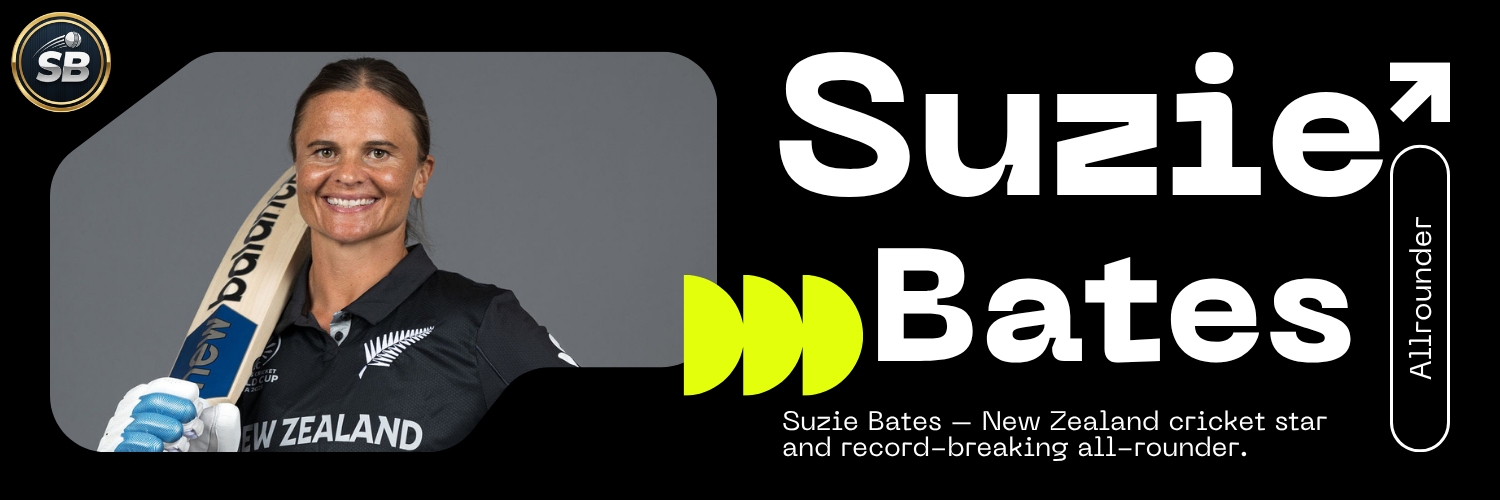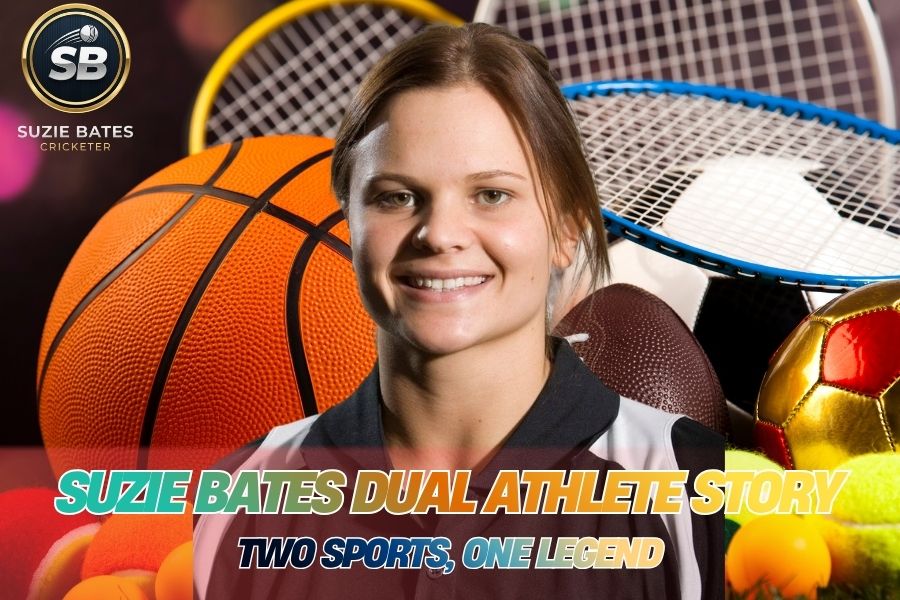From backyard games in Dunedin to the Olympic courts of Beijing and the World Cup pitches of cricket, Suzie Bates built a legacy across two sports. Her dual athlete story is one of balance, resilience, and joy – proving that greatness doesn’t need a single path.
Early Days: Growing Up Between Hoops and Boundaries
For Suzie, sport wasn’t a choice – it was a rhythm. Growing up in the southern city of Dunedin, she and her three brothers spent their days outdoors, bouncing between backyard cricket and community basketball courts. Her parents, Robin and Jo Bates, encouraged every kind of movement, from athletics to netball, as long as it brought joy.
At Otago Girls’ High School, her dual passions began to crystallize. She was captain of both the school’s cricket and basketball teams and spent most weekends shuttling between gymnasiums and cricket nets. Teachers remember her carrying two sets of gear – a bat in one hand, a basketball in the other – and switching sports without a hint of fatigue.
“Even then, she had this unbelievable focus,” recalls one former coach quoted by Sport NZ. “You could tell Suzie didn’t just love playing; she loved competing – whatever the sport.”

The First Love: Basketball’s Pull
While many know Suzie Bates as a cricket legend, her first serious sporting ambition was on the hardwood. She was a standout guard for Otago at the national level and earned a spot on the New Zealand Tall Ferns development squad in her teens.
Her ball-handling, court vision, and defensive awareness set her apart – qualities that would later shape her cricket captaincy. Coaches often described her as “a playmaker who made others better,” a theme that would echo throughout her dual career.
By her early 20s, Suzie was a mainstay in the Tall Ferns, traveling internationally for tournaments while still maintaining her cricket commitments with the Otago Sparks. In 2008, her dream peaked when she represented New Zealand Basketball at the Beijing Olympics – an achievement few cricketers in history can claim.
“It was surreal,” she told NZ Basketball years later. “You’re walking into an Olympic Village surrounded by the best athletes in the world, and you think – how did a kid from Dunedin who plays cricket end up here?”
The Crossroads: Two Jerseys, One Decision
By 2008, Suzie had reached the rare point where both sports demanded full commitment. The Olympic experience was extraordinary, but so was her rising profile in cricket. That same year, she smashed 168 off 105 balls against Pakistan – the highest score in women’s ODI history at the time.
The calendar, however, wasn’t as forgiving. Cricket tours overlapped with basketball seasons, training schedules collided, and recovery became an art form.
“There was a point where I was doing basketball conditioning in the morning and cricket nets in the afternoon,” she recalled in an ESPNcricinfo interview. “I loved it, but I was running out of time to breathe.”
The defining moment came when the White Ferns offered her a leadership role ahead of the 2010 ICC Women’s World Twenty20. Choosing cricket wasn’t about giving up basketball – it was about sustainability. She realized she could still love both, but lead one.

The Dual Mindset: What Basketball Taught Cricket
Even after focusing full-time on cricket, basketball never left her. The two sports fed each other – one teaching precision, the other patience.
Basketball sharpened her spatial awareness and tactical instincts. As a point guard, Bates learned how to read plays, anticipate opposition moves, and control tempo – skills she later applied as a cricket captain.
“I think basketball made me a better cricketer,” she told Wisden. “It forces you to make decisions in seconds. In cricket, especially in T20s, that translates perfectly.”
Her time in basketball also built her fitness and agility – rare assets in women’s cricket at the time. Coaches noted her ability to move laterally, dive sharply in the field, and rotate strike effortlessly. These weren’t coincidences; they were habits born from the court.
See more at Profile & Career.
Balancing Two Worlds
Dual-sport life wasn’t glamorous – it was grueling. Suzie’s years balancing both sports were filled with early flights, late training sessions, and constant recovery. During university at Otago, she often attended morning lectures, trained basketball at noon, and played cricket matches in the evening.
But she never saw it as sacrifice.
“I think being a dual athlete kept me sane,” she told Balance Is Better. “It meant when one sport was frustrating, the other gave me a break. You don’t get burnout when you’re always learning something new.”
That mindset now influences how she mentors young players. She advocates for multi-sport participation in youth, arguing that early specialization narrows skills and stifles creativity. “You find your best game when you play many games,” she often says.
The Return to Basketball
Even after shifting her professional focus to cricket, Bates couldn’t resist the lure of the basketball court. In 2014, she made a brief return, playing for Otago Gold Rush in New Zealand’s Women’s Basketball League. She led the team in scoring and assists – proving that her basketball instincts hadn’t dulled.
“I was nervous I’d forgotten how to shoot,” she laughed in a Stuff.co.nz interview. “Turns out it’s like riding a bike – just a bit sweatier.”
Her comeback reignited discussions about cross-training and longevity. How could one athlete excel in two sports at national level – and keep doing it without burnout? The answer, as always, was Bates’s balance.
Lessons From Two Courts
By 2020, Suzie Bates had become New Zealand’s most capped women’s cricketer, amassing over 10,000 international runs. Yet she still speaks about basketball with the same affection she reserves for cricket.
The lessons overlap seamlessly:
- Vision: Reading angles in basketball improved her field placement.
- Decision-making: Fast passes became quick singles.
- Team rhythm: Understanding how momentum flows – in quarters or overs – helped her captaincy.
- Emotional resilience: Losing by two points or two runs hurts the same, she says, “but both teach you to move on fast.”
She often tells young athletes that dual-sport life taught her how to learn. “Once you know how to adapt between sports, you can adapt to anything – formats, conditions, even failure.”
The Legacy of a Dual Athlete
In an age where sport increasingly rewards early specialization, Suzie Bates’s story stands out as both anomaly and inspiration. She is living proof that versatility builds endurance, not distraction.
Her name now appears in both the ICC Hall of Fame shortlists and New Zealand’s basketball archives. Few athletes in the world – male or female – have represented their country at both the Olympics and Cricket World Cup.
For Bates, the dual athlete label isn’t about being divided; it’s about being whole.
“When I look back,” she told Olympic.org.nz, “I don’t think about what I gave up – I think about what I got to do. Two teams, two families, two sets of lessons that made me who I am.”
Beyond Titles, Beyond Borders
Today, in her mid-thirties, Suzie Bates continues to play international cricket with the same passion she had as a teenager switching between gym and nets. Her legacy transcends runs and rebounds.
She remains a global advocate for women in sport – particularly for maintaining balance, joy, and perspective. Her career embodies an idea that feels revolutionary in elite athletics: that you can love more than one thing, and do both well.
In an interview for Balance is Better, she summed it up perfectly:
“People used to ask when I’d pick one. I never did. I just picked effort. And that’s worked out fine.”
Suzie Bates’s dual athlete story isn’t about division – it’s about synthesis. It’s a reminder that greatness isn’t a straight line; sometimes, it’s two intersecting paths that lead to one extraordinary life.
Discover Suzie Bates’ dual athlete story – how New Zealand’s icon balanced basketball and cricket to become one of the greatest multi-sport stars in history.


